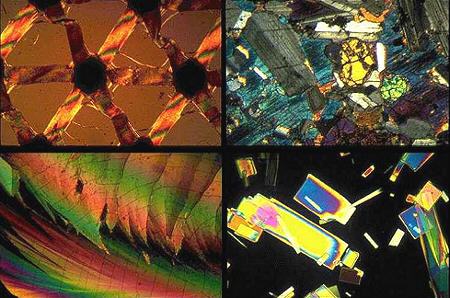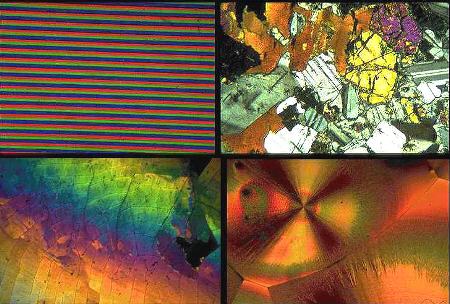Subjects for polarised light microscopy
by Mike Samworth
I always like looking at various things under plane polarised
light or between crossed polars. All sorts of slides,
particularly botanical slides can look altogether different
between crossed polars and it is well worth trying with any slide
just to see what sort of effect you get. However, there are a
number of things that can be almost guaranteed to give a visual
delight when looked at in this way. In this article I have given
examples of some of these that I have tried.
Four images between crossed polars by Mike Samworth


A
This is the gauze from the back of a piece of Elastoplast.
The slide was given to me by Doug Morgan as a thank you for some
labels I did for him.
B
This is a thin rock section, Olivine Gabbro, taken from a
slide that was in a PMS box. You can identify
minerals from images like this though I just like the way they
look. Well worth rotating the slide to get the best view.
C
Sulphur, melted on a slide and a coverslip pressed onto it
whilst molten. It is advisable to make several of such slides as
you can never tell by eye what is going to yield reasonable
images. Even then, only a small section of the slide is likely to
be adequate.
D
Tartaric acid crystals, not sure exactly how prepared since
this is another PMS box slide and there were no details in the
notebook. Another unknown is that this was taken on Polaroid
Chrome presentation film.
Four more images between crossed polars.

A
This is Polarchrome film, made by Polaroid. It is sold as a
slide film that can be processed in a matter of minutes using a
small processor device. It is a filtration method much like the
Duffay colour film that used to be available. Basically the
emulsion is monochrome but is behind a tricolour filter, the
alternate bands seen in the image. These same bands act as a
filter again when the slide is viewed or projected.
B
Another thin rock section, and another gabbro. I wish I knew
more about this subject.
C
Another sulphur melt, notice how different this is from the
last one. Just goes to show how unpredictable this sort of thing
is.
D
Good old Vitamin C. This slide was made by evaporating a
saturated solution of Vitamin C. The solution can be made on the
slide itself, just put a bit of powder the size of a pin head
onto a VERY clean slide and add a drop of distilled water. Mix in
with a pin and then put onto a warm surface such as a hot plate.
As the water evaporates make scratch marks with the pin. This
will cause crystal growth to go in lines, you can alter the
growth by breathing on the slide.
I hope that you feel inspired enough to try your hand at
making some slides. There are all sorts of other subjects that
can be tried. Epsom salts is good for crystal slides, as is
aspirin. Some plants have small scales on the leaves and I hope
to make some slides of these soon. As soon as I get my hands on
some sea-buckthorn leaves that is. Staffordshire doesn't have
much of a coastal flora!
All images taken by Mike Samworth ©.
Please take the time to ask any questions or
make any comments to me
Mike Samworth.
Editor's note:
Also see an illustrated
article by Mike Samworth on how to prepare and view a slide
of paracetamol between cross polars .
Two articles describing how to obtain and use polarised light
filters are 'Technicolour Nature' - Lighting techniques for the
novice Part 1 and Part 2.
PMS is the Postal Microscopical Society,
UK. Return to article.
© Microscopy UK or their
contributors.
Please report any Web problems
or offer general comments to the Micscape Editor,
via the contact on current Micscape Index.
Micscape is the on-line monthly
magazine of the Microscopy UK web
site at Microscopy-UK
WIDTH=1
© Onview.net Ltd, Microscopy-UK, and all contributors 1995 onwards. All rights
reserved. Main site is at www.microscopy-uk.org.uk with full mirror at www.microscopy-uk.net.


